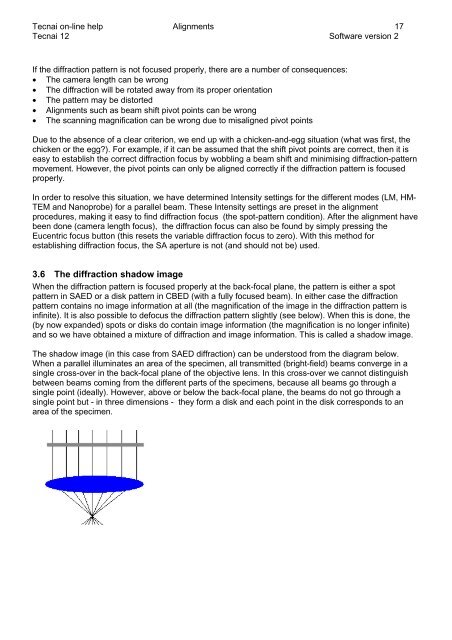Tecnai on-line help manual -- Alignments - UT Southwestern
Tecnai on-line help manual -- Alignments - UT Southwestern
Tecnai on-line help manual -- Alignments - UT Southwestern
- No tags were found...
You also want an ePaper? Increase the reach of your titles
YUMPU automatically turns print PDFs into web optimized ePapers that Google loves.
<str<strong>on</strong>g>Tecnai</str<strong>on</strong>g> <strong>on</strong>-<strong>line</strong> <strong>help</strong> <strong>Alignments</strong> 17<str<strong>on</strong>g>Tecnai</str<strong>on</strong>g> 12 Software versi<strong>on</strong> 2If the diffracti<strong>on</strong> pattern is not focused properly, there are a number of c<strong>on</strong>sequences:• The camera length can be wr<strong>on</strong>g• The diffracti<strong>on</strong> will be rotated away from its proper orientati<strong>on</strong>• The pattern may be distorted• <strong>Alignments</strong> such as beam shift pivot points can be wr<strong>on</strong>g• The scanning magnificati<strong>on</strong> can be wr<strong>on</strong>g due to misaligned pivot pointsDue to the absence of a clear criteri<strong>on</strong>, we end up with a chicken-and-egg situati<strong>on</strong> (what was first, thechicken or the egg?). For example, if it can be assumed that the shift pivot points are correct, then it iseasy to establish the correct diffracti<strong>on</strong> focus by wobbling a beam shift and minimising diffracti<strong>on</strong>-patternmovement. However, the pivot points can <strong>on</strong>ly be aligned correctly if the diffracti<strong>on</strong> pattern is focusedproperly.In order to resolve this situati<strong>on</strong>, we have determined Intensity settings for the different modes (LM, HM-TEM and Nanoprobe) for a parallel beam. These Intensity settings are preset in the alignmentprocedures, making it easy to find diffracti<strong>on</strong> focus (the spot-pattern c<strong>on</strong>diti<strong>on</strong>). After the alignment havebeen d<strong>on</strong>e (camera length focus), the diffracti<strong>on</strong> focus can also be found by simply pressing theEucentric focus butt<strong>on</strong> (this resets the variable diffracti<strong>on</strong> focus to zero). With this method forestablishing diffracti<strong>on</strong> focus, the SA aperture is not (and should not be) used.3.6 The diffracti<strong>on</strong> shadow imageWhen the diffracti<strong>on</strong> pattern is focused properly at the back-focal plane, the pattern is either a spotpattern in SAED or a disk pattern in CBED (with a fully focused beam). In either case the diffracti<strong>on</strong>pattern c<strong>on</strong>tains no image informati<strong>on</strong> at all (the magnificati<strong>on</strong> of the image in the diffracti<strong>on</strong> pattern isinfinite). It is also possible to defocus the diffracti<strong>on</strong> pattern slightly (see below). When this is d<strong>on</strong>e, the(by now expanded) spots or disks do c<strong>on</strong>tain image informati<strong>on</strong> (the magnificati<strong>on</strong> is no l<strong>on</strong>ger infinite)and so we have obtained a mixture of diffracti<strong>on</strong> and image informati<strong>on</strong>. This is called a shadow image.The shadow image (in this case from SAED diffracti<strong>on</strong>) can be understood from the diagram below.When a parallel illuminates an area of the specimen, all transmitted (bright-field) beams c<strong>on</strong>verge in asingle cross-over in the back-focal plane of the objective lens. In this cross-over we cannot distinguishbetween beams coming from the different parts of the specimens, because all beams go through asingle point (ideally). However, above or below the back-focal plane, the beams do not go through asingle point but - in three dimensi<strong>on</strong>s - they form a disk and each point in the disk corresp<strong>on</strong>ds to anarea of the specimen.
















